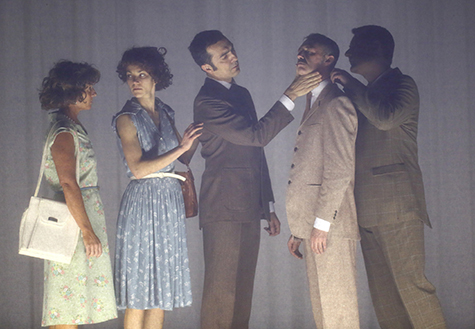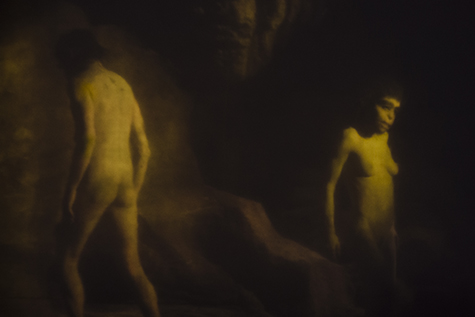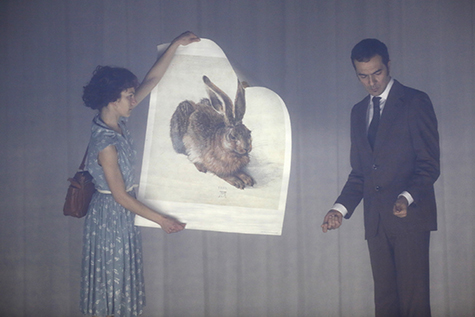Exiled from our being
Ben Brooker: Socìetas Raffaello Sanzio, Go Down, Moses

Societas Raffaello Sanzio, Go Down, Moses, Adelaide Festival 2016
photo Tony Lewis
Societas Raffaello Sanzio, Go Down, Moses, Adelaide Festival 2016
In Go Down, Moses, Italian auteur Romeo Castellucci reconceives the Book of Exodus’ story of Moses, liberator of the Israelites, as an elliptically sequenced dreamscape that “transfigures the various moments of the life of Moses” [program]. Each episode is filtered through a stridently contemporary aesthetic, narrative causality eschewed in a startling weave of deconstructed mythologies and mises en scènes almost overwhelming in their vivid, painterly composition.
In a prologue of sorts that commences while the house lights remain up, well-heeled visitors to an art gallery move about purposelessly. In the seeming absence of anything to look at, they begin to objectivise each other in an eerily impersonal exchange of touches and what look like measurements based on various body lengths (perhaps referencing the cubit, the ancient unit that appears in the Bible, describing the distance from elbow to fingertip). The movement is abstracted and unsettling, recalling the grim history of institutional attempts to classify individuals into discrete races and character types. A repeated gesture, something like the thrusting of a knife, periodically scatters the visitors, who nonchalantly regroup in different parts of the space, all memory of the earlier violence forgotten or suppressed.

Societas Raffaello Sanzio, Go Down, Moses
photo Guido Mencari
Societas Raffaello Sanzio, Go Down, Moses
One member of the party finds a reproduction of Dürer’s masterpiece of observational art, Young Hare, on the floor and affixes it to the wall as if to say ‘there—now you have something to look at’ (Castellucci is, in his own way, saying the same thing, both acknowledging and ironising our voracious relationship to his art). Unmoved by the painting, the visitors saunter off, Scott Gibbons’ elusive soundscape of muffled pops and clicks giving way to the roaring of an industrial turbine, the gigantic, captivating object—the one the gallery visitors, and we, the audience, have been waiting for?—having materialised during a blackout. The scalps of three women, long hair trailing, descend slowly from the ceiling, their ensnarement by the turbine’s rotor a profoundly unnerving inevitability (the sequence is, superfluously, later repeated without meaningful variation).
The drone of the turbine extends, momentarily, into the third scene wherein a young woman (Rascia Darwish) occupies a remarkably lifelike toilet cubicle, from which we are distanced by a scrim that remains in place for the duration of the work. Bleeding below the waist and in visible pain, she stuffs toilet paper between her legs and chaotically veers from cistern to sink, smearing the walls and mirror with her blood. Hemorrhaging after having given birth in secret, this is Castellucci’s Jochebed, mother of Moses, filtered through a contemporary lens that sees emoticons projected onto the scrim throughout her ordeal—a withering, if rather gauche, statement on our technologised indifference to suffering.
We are provided a brief glimpse of the baby’s fate—alive, put in a plastic bag and cast into a dumpster, reflecting the Biblical narrative in which Moses is abandoned on the banks of the Nile—before the woman is questioned by police (English surtitles accompany the Italian dialogue). Even allowing for the implausibility of such an interview occurring prior to medical treatment, this scene’s relative naturalism vexes, and feels overly self-conscious in its calculated, unimaginative appropriation of the conventions of the police procedural. It becomes interesting only when the woman’s refusal to reveal the location of her baby—an unthinkable dereliction of feminine duty in the eyes of the detective (Sergio Scarlatella)—gives way to apocalyptic ramblings (“there are animals all over the floor, they live in the same world as us”) and seer-like declarations (“we have meat to eat and we are sated but we are slaves”).
At the conclusion of the interview, the woman is placed in a CT scanner. As the platform slides into the tunnel, penetrative resonances are unavoidable given the significance of fertility in Castellucci’s reimagining of the Moses myth (a second baby, as well as heterosexual intercourse, feature in the final vignette). In an astonishing coup de théâtre, the woman emerges into a vast, exquisitely rendered prehistoric cave replete with opening that looks out onto a crepuscular, star-flecked sky. As mathematician John Playfair remarked in Scotland in 1786 when he saw the Siccar Point “angular unconformity”—discrete geological layers suggesting vast time spans—“the mind grows giddy by looking so far into the abyss of time.”

Societas Raffaello Sanzio, Go Down, Moses, Adelaide Festival 2016
photo Tony Lewis
Societas Raffaello Sanzio, Go Down, Moses, Adelaide Festival 2016
Sacred choral music, contemplative in tone but resounding in volume, accompanies the arrival of a group of early humans (actors in prosthetics) who, manifesting the woman’s vision of sated slaves, consume a meal of dried meat prior to burying and, briefly, mourning a stillborn baby. Their balletic, slow motion movements are observed by a second group of humans, a competing tribe perhaps, who gather at the mouth of the cave. Two of the cave dwellers copulate, bringing to mind the doctrine of original sin, the Biblical Fall that Genesis tells us corrupted all human nature.
And yet the act, on reflection, feels cyclical rather than foundational, connecting these early humans across the gulf of deep time to both their ancestors and descendants. They have a message for us, scrawled in red pigment across the wall of the cave, SOS, that ripples through the space and time that separate us. The presence of the woman, our avatar, collapses temporality, spatiality.
We have, by this point in the evening, already heard Empire Jubilee Quartet’s take on Wade in the Water, the Negro spiritual whose lyrics (wade in the water, children/God’s gonna trouble the water) reflect the Israelite slaves’ escape from Egypt. But Castellucci’s most distinctive manoeuvre is to project the Moses myth beyond its established associations – its primacy, namely, as a symbol of African American emancipation – towards what he thinks of as ‘our incorporeal slavery’, that of ‘people exiled from being’ [director’s note].
Seen through this lens, all of humanity is subject to different slaveries: not physical and economic bondage à la the 19th century slave trade, but, for instance, helpless attachment to technology (the emoticons) and the perpetuation of gender-based oppression (one obvious reading of the pulverised scalps). Then there are those slaveries that exist beyond the physical world: subconscious drives, and a form of race memory – Jung’s idea of a collective unconscious – that links us to the early humans depicted in the final sequence. Seen in this way, the function of Moses is not so different from the Biblical myth: as a figure of salvation who can lead humanity out of servitude and into the Promised Land. What might it say about us that Castellucci’s Moses remains, for all we know, squirming unfound within an overflowing dumpster beside a forgotten byroad?
Read Ben Brooker’s interview with Romeo Castellucci.
–
Adelaide Festival of Arts 2016: Go Down, Moses, direction, set, costumes, lighting Romeo Castellucci, music Scott Gibbons, text Claudia Castellucci, Romeo Castellucci, Dunstan Playhouse, Adelaide Festival Centre, 25-28 Feb
RealTime issue #131 Feb-March 2016, web






